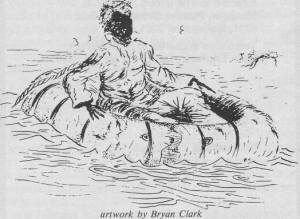- Author
- Clark, Bryan
- Subjects
- History - WW2
- Tags
-
- RAN Ships
- HMAS Sydney II
- Publication
- December 1989 edition of the Naval Historical Review (all rights reserved)

Deceased
On a steep, scrubby hillside at Flying Fish Cove, on Christmas Island, washed by the waves of the Indian Ocean, is the neglected grave of an unknown sailor who, some believe, may be the only HMAS Sydney crewman to be buried ashore.
The sailor’s origins are a mystery. Surprisingly, no investigation conducted by Australian naval authorities to determine an identity has been successful. Was he one of the 645 Australian crew who disappeared after the HMAS Sydney’s horrendous battle with the famous German raider, HSK Kormoran, in 1941, about 550km off the Carnarvon coast?
Christmas Island, in 1942, was rife with tension as Japanese submarines encircled the shore. Already a Norwegian phosphate freighter, Eidsvold, had been torpedoed on January, 1942, about 100 metres offshore.
Early in the evening of Friday, February 6, some Chinese and Malay Coastwatchers, stationed at lookout posts around the island, spotted through binoculars a floating object, carrying a body. A pilot craft towed it to the jetty. The object was a life raft, or Carley Float, carrying the corpse of a man. An unclassified Department of Defence document records the observations of the Christmas Island harbour master, Captain J. Smith: “…The…float…was undoubtedly of Naval pattern. The wooden decking was branded with the word PATENT, and one hole, apparently caused by a bullet, was found in this decking. The outer covering was…damaged in several places, a few pieces of metal being found embedded in the kapok filling. One of these pieces, in the opinion of the gun’s crew on the island, was what remained of a bullet. The inside framework, also the divisions between the buoyancy tanks, were branded as follows: LYSAGHT DUA-ANNEAL ZINC. MADE IN AUSTRALIA inside.”
“All the roping attached to the float had a red yarn running through the strands. The canvas shoe found on the float was branded either McCOWAN or McEWEN, also PTY, followed by a crown and/or a broad arrow.”
“The corpse was clothed in a boiler suit which had originally been blue, but was bleached white by exposure. There were four plain press buttons from neck to waist… The fact that a red yam was found in the strands of the roping appears important, and would be one of the first things to attract the attention of a practical man…”
At the time, J. Baker, of the Christmas Island radio station, expressed his “…desire that all information given be treated as unofficial” before recording his observations. Joseph ‘Bunny’ Baker lived on C.I. during the era 1935-42. He died in his native England on April 6, 1987. Prior to his passing, he described to C.I. historian, Marg. Neale, the event involving the arrival of an unknown seaman’s body in a drifting Carley Float. He said:
“The… incident… brought us a little closer in touch with reality. (It) occurred on about 6 February (1942). When looking out to sea we noticed a large concentration of sea birds circling and gliding, about two or three miles away. Normally we would have paid little attention to this, as it would indicate that a school of fish was exciting them. Somehow their behaviour seemed a little abnormal and quite different. By using binoculars, we were able to make out the object on the surface of the water which was attracting their attention. Although we were in some fear of the submarine that was besieging us, it was thought that we should investigate. Three of us took one of the small launches and put to sea, keeping a wary look-out as we chugged along. As we drew nearer to the object it seemed to be a Carley Float, somewhat low in the water, with about six inches of water in it, plus a body lying with arms out-stretched…”.

“It was obvious that the float had been at sea for quite some time, for there was much weed growth both inside and outside. The occupant had suffered much, either from the sea birds or from explosive damage. Taking the float in tow, and not knowing whether we had found either friend or foe, we reached the jetty where it was lifted by crane onto the wharf. The body was taken to the hospital by the doctor for examination while Reg Smith and I inspected the float. It had been made in Australia, and a pathetic looking shoe beside the body revealed that its owner had probably been an Australian, and it was an Australian Government issue. According to the Medical Officer at the time, this shoe did not belong to the dead man. There may have been other people on the raft”.




